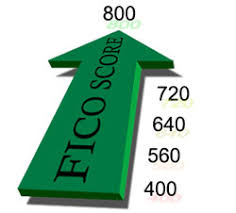Lenders’ Credit Score Requirements May Be More Strict Than Necessary

FICO scores run from 300 to 850. Wells Fargo recently lowered in minimum acceptable scores for conventional loans to 620 from 660. Could this signal the start of some fresh thinking on credit scores? As Realtors, we certainly hope this is the case. As much as stricter credit scoring models were needed after the banking crash in late 2007, credit has been unreasonably tightened to the point that “good borrowers” were still unable to get loans. This includes First Time Home Buyers, the Self-Employed, and Move-Up Buyers who had to switch jobs or careers due to downsizing during the recession.
Are lenders’ credit score requirements for home buyers this spring too high — out of sync with the actual risks of default presented by today’s borrowers? The experts say yes. We agree.
What experts are we talking about here? The actual developers of the credit scores used by virtually all mortgage lenders. Executives at both FICO, creator of the dominant credit score used in the mortgage industry, and up-and-coming competitor VantageScore Solutions, confirmed that mortgage lenders could reduce today’s historically high score requirements without raising their risks of loss. In the process, many prospective buyers who currently can’t qualify might get a shot at a loan approval. This will be a good thing for buyers and sellers alike, and will help keep the housing market going in the right direction.

Consider this: Consumer behavior in handling credit is subject to change over time, often keyed to regional or national economic conditions. Credit scores that were acceptable risks in the early 2000s — say FICOs in the 640-to-680 range — turned into larger-than-anticipated losers when the recession hit. Now that the housing rebound is well underway and federal regulators have imposed tighter standards on income verification and debt ratios, the high credit score “cutoffs” that virtually all mortgage lenders imposed in the scary aftermath of the crash are stricter than necessary.

FICO scores run from 300 to 850. Lower-risk borrowers have high scores, and higher-risk consumers have low scores. Early in the last decade, a FICO score of 700 was good enough for an applicant to get a lender’s best deals or close to it. Today a 700 FICO just barely makes the grade — 50-plus points below the average score for home purchase loans at Fannie Mae and Freddie Mac, the big investors. Banks now need to package and sell their loans on the secondary market, and if a homeowner defaults on the loan and the Underwriter review team finds something potentially amiss, the bank or lender now has to “buy back” the bad loan. Not something lenders want to do in the aftermath of such past, big bank failures due mainly to bad loans.


Joanne Gaskins, senior director of scores and analytics for FICO, said that statistical studies by her company have demonstrated that “the risk of default on more recent mortgage vintages is better than at the onset of recession” — essentially real risk has reverted to the early 2000s. A lot more people pay on time. As a result, she said, lenders can afford to “take a look” at their current strict scoring requirements and consider lowering them without sacrificing safety.
To illustrate how consumer behavior has improved, Gaskins cited one internal study that examined mortgage default data through 2011. At a FICO score level of 700 in 2005, roughly 36 borrowers paid their loans on time for every one who went into serious default. In 2011, by contrast, for every one defaulting mortgage borrower, roughly 91 paid on time. That’s a huge decrease in risk to the lender.

VantageScore Solutions has documented a similarly dramatic improvement in mortgage borrower payment behavior. In an article scheduled for publication this week in Mortgage Banking, a trade journal, Barrett Burns, president and chief executive of VantageScore, offers an analysis based on scores of 680 and 620 from 2003 through 2012. VantageScore’s latest scoring model uses a high risk to low risk scale of 300 to 850.
According to Burns, the probability of default at both score levels was lowest in 2003-05, then soared between 2006 and 2008 as the economy began deteriorating. By 2012, both scores were just slightly higher than 2005’s.

Burns notes that although auto lenders and credit card banks have adjusted their underwriting standards to these important changes in borrower risk, “the mortgage industry has been hesitant.” In an interview, Burns emphasized that mortgage lenders could expand home purchase possibilities for large numbers of consumers simply by lowering score cutoffs. They wouldn’t have to loosen up on their standards on down payments or debt ratios — just their scores.
A study last year by the Urban Institute and Moody’s Analytics estimated that every 10-point reduction in mandatory credit scores on mortgages increases the pool of potential borrowers 2.5%. A 50-point cut in score requirements, researchers found, would increase potential home purchases 12.5% — more than 12.5 million households.

At least one major bank has concluded that lowering scores is the way to go. Wells Fargo , www.wellsfargo.com, recently announced reductions in minimum acceptable scores for conventional loans to 620 from 660. They are joining other major banks in lowering the acceptable score threshold for FHA loans to 600. See the article here from Bloomberg News.
Could this signal the start of some fresh thinking on credit scores, a trend that other large lenders will pick up on? Let’s see. If they do so, it should be a win-win for everybody involved.
Copyright  2014 New Home Buyers Brokers, Inc. / Realty Pros. With excerpts from: Kenneth R. Harney, Washington Post Writers Group
2014 New Home Buyers Brokers, Inc. / Realty Pros. With excerpts from: Kenneth R. Harney, Washington Post Writers Group









